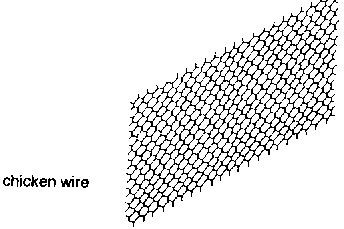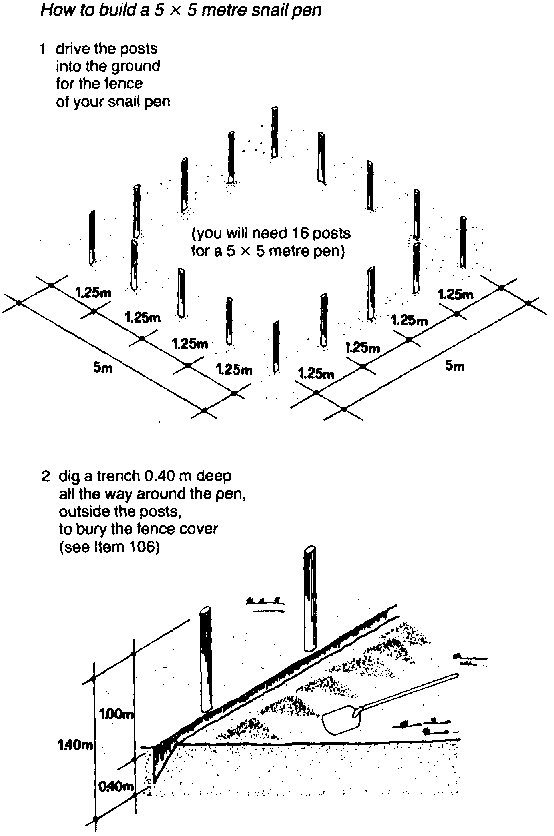
| Farming snails 1: Learning about snails; Building a pen; Food and shelter plants հղում աղբյուրինfb33fe.htm |
|
Building a pen
97. Build a pen for your snails as soon as you can after you have burned the plant material. This is to keep other insects, mice, rats or shrews from getting into your pen.
98. A snail pen is a simple fenced- in area and you can build a fence using
• corrugated sheet metal or plastic sheets
• woven plant material
• woven plant material with chicken wire

Materials for fence
Using corrugated sheet metal or plastic sheets
99. A fence of corrugated sheet metal or plastic sheets makes the best pen for snails because it keeps out their enemies very well. However, sheet metal or plastic costs a lot of money.

A fence of corrugated sheet metal
100. If you are going to build a pen using corrugated metal or plastic, you must build it in such a way that the enemies of snails cannot get in between the sheets.
Using woven plant material
101. To save money, you can build a fence of woven plant material such as split bamboo. If the woven material is tight, it will keep out enough of enemies for you to farm snails.

Woven material
Using woven plant material with chicken wire
102. If you can get fine- mesh chicken wire, you can improve a fence that is made of woven material.

Chicken wire
103. To do this, first make the fence of chicken wire and then cover it with woven material.

First use chicken wire then cover it with woven material
104. The chicken wire will keep out rats and other small animals. The woven plant material will keep most of the insects out and keep the snails in.

Keep out small animals
Note
With any kind of pen animals such as rats may get in, and this is especially true with pens made only of woven plant material. So, you must always watch for rats and other animals and keep them out.
How to build the fence
105. Build the fence as you would any fence, by driving posts into the ground. Use posts 1.40 metres long. When the posts are in place they should be 1.00 metre above and 0.40 metre below the ground.

Drive posts into the ground
106. Whatever material you use for the fence of your pen, it should be buried 0.40 metre below the ground.
107. If you are using woven material you will have to change the bottom of the fence when it rots.
108. This can be done more easily by making the woven material in two parts, one for the top and one for the bottom. When the bottom part rots, you can change it without having to change the whole fence.

Attach top parts first; attach bottom parts second
Keeping your snails in the pen
109. Many of your snails may crawl over the fence and get out of the pen. If you build a flap on the inside at the top of the fence, it will be more difficult for your snails to get out.
110. However, even with a flap some snails may get out, and for this reason many snail farmers put two flaps on their fence. With two flaps they find that fewer snails get out.

With two flaps, your snails will not easily crawl out of the pen
Note
If you make your pen using galvanized sheet metal, you will not need flaps. Snails will not crawl on galvanized sheet metal.
111. The drawings show you how to build a 5 x 5 metre pen using woven plant material, with and without chicken wire and how to build flaps to keep your snails in.

How to build a 5 x 5 metre small pen
3 if you are using woven material only, attach it as you were told to do in Item 108

Attach woven material
4 If you are using chicken wire and woven material, attach the chicken wire first and then the woven material

Attach the chicken material first
5 be sure that the fence cover goes all the way to the bottom of the 0.40- m trench

0.40- m trench
6 fill in the trench

Fill in the trench
7 attach the flaps to the inside of the pen
Note: use woven material 0.25 m wide for the flaps
8 first attach the bottom flap using heavy cord

Use heavy cord
9 then attach the top flap